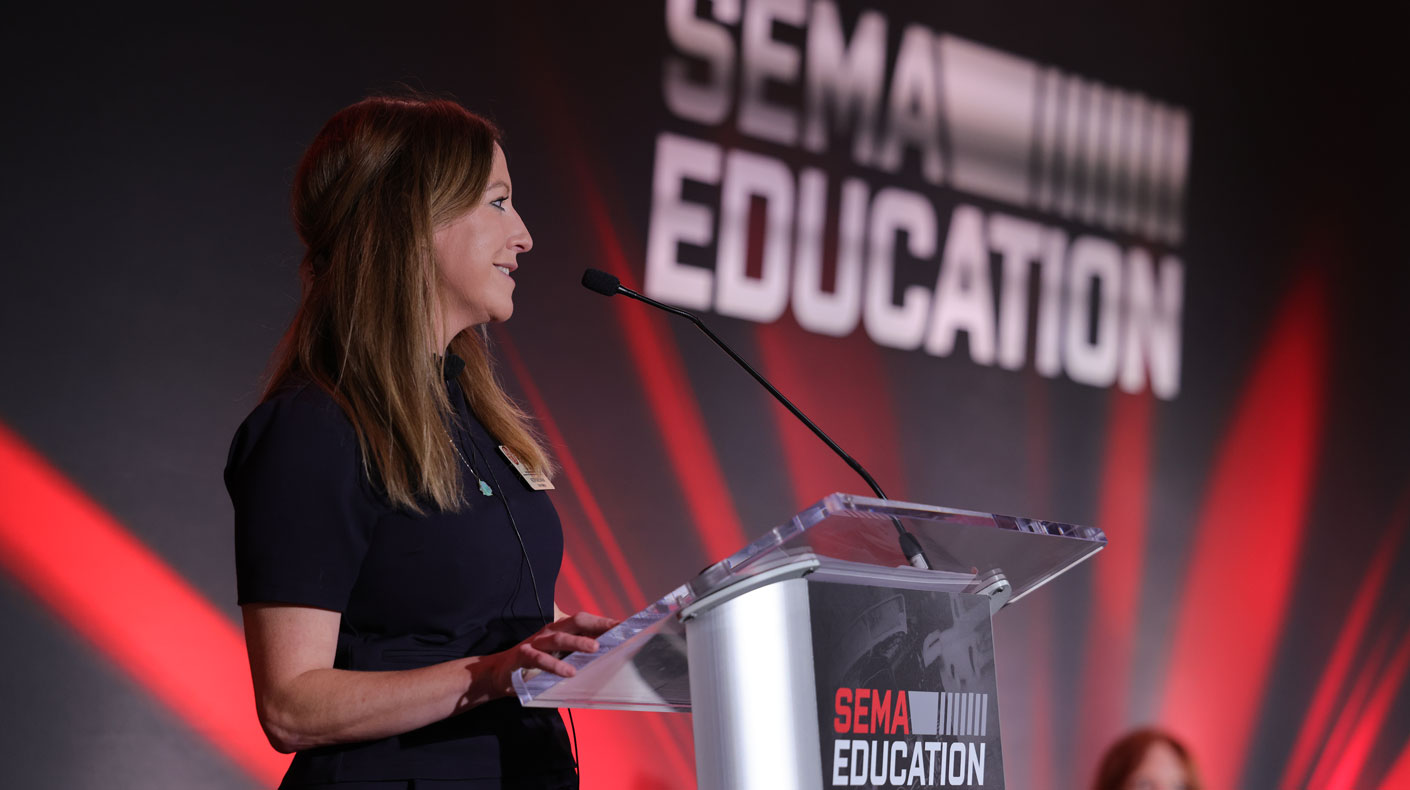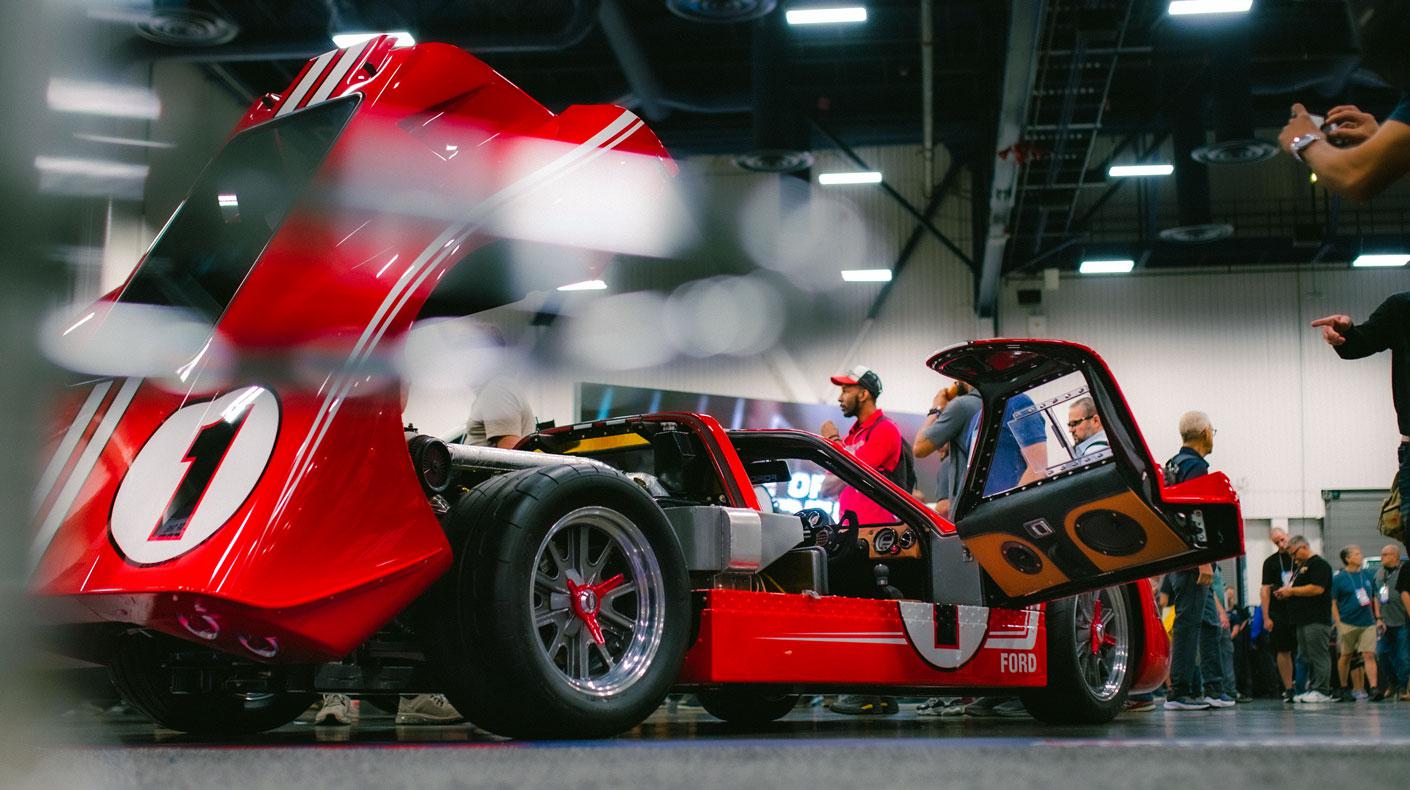SEMA News—December 2019
BUSINESS
ADAS Problem Solving
Hansen VTF Labs Demonstrates the Opportunity It Has Found in Calibration Services
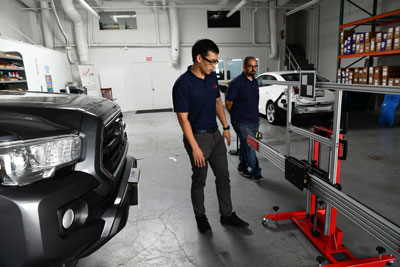 Hansen VTF Labs general managers Kevin Yen (left) and Steve Korkis prepare to calibrate the lane-departure alert on a Toyota Tacoma. The test-fit center has enhanced its business model with ADAS diagnostic services to meet a growing aftermarket need. |
As OEMs roll out an expanding array of advanced driver-assistance systems (ADAS) on their new vehicles, the latest technologies are proving to be a mixed bag for the aftermarket. On one hand, they open new product channels for the industry’s suppliers and retailers. On the other, they present a challenge to collision-repair, customization and installation shops, all of which must contend with the safe functionality of ADAS components on completed projects.
However, every challenge is an opportunity in disguise, and at least one aftermarket service provider is emerging as a case study in leveraging ADAS technologies. Located in Anaheim, California, Hansen VTF Labs was co-founded in 2001 by brothers Chuck Hansen and David Hansen Sr. of Hansen Auto Body & Paint. Drawing upon their collision-repair experience, they set about offering aftermarket manufacturers a creative test-fit center for the research, design and production of high-quality parts. Today, Hansen VTF’s preproduction services include CAD and R&D assistance, jig and mold creation, digital scanning, master part selection, and vehicle test fits. The lab boasts ISO 9001:2015 certification and I-CAR-certified auto body technicians who bring a real-world view to their work.
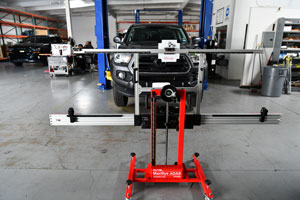 The Tacoma was elevated to simulate a 6-in. aftermarket lift. The team used Autel MaxiSys ADAS calibration equipment to demonstrate that a simple vehicle software adjustment and calibration would bring the lane-departure feature back into compliance. |
In 2019, the company added ADAS calibration to its list of services, giving collision repairers and other aftermarket businesses a speedy, cost-effective alternative to dealership or in-house ADAS calibrations. SEMA News recently toured the facility to see its business model firsthand. Although obviously a technology expert himself, President and CEO Chuck Hansen let his staff take the lead in explaining the lab’s operations.
“We decided that ADAS is something new and is going to be very important, so we have taken the initial investment to purchase equipment, get the training, get the knowledge, and help collision-repair shops improve cycle time,” said Steve Korkis, Hansen VTF Labs general manager. “Yes, they can take a vehicle to a dealer, but we all know the process. You can spend hours there waiting for a service adviser. They write you up, the vehicle goes to the back, and who knows when that technician gets to it? It could be two days, three days or even four days, from what we understand from some of the shops that we work with. So we are presenting same-day turnaround. We get the vehicle in, assess what needs to be calibrated, including pre-scans and post-scans, and then go from there.”
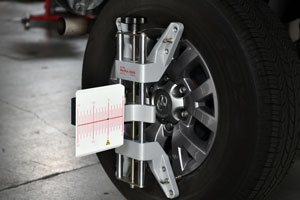 Laser targets on the Tacoma’s wheels helped ensure that all of the calibration equipment was properly aligned. Hansen VTF Labs carefully follows all OEM-specified procedures for each vehicle’s tests. |
“After each ADAS calibration we perform a test drive to make sure everything is operating correctly before returning the vehicle to the customer,” added Kevin Yen, also a Hansen VTF general manager. “We want to make sure the vehicle is returned to its pre-collision condition.”
Yen noted that there are both dynamic and static calibrations associated with many ADAS systems, meaning that some functions will calibrate on their own while others will not. The trick is knowing what you’re dealing with—and it can vary from maker to maker and model to model.
The facility also serves as a proving ground for aftermarket products aimed at ADAS-equipped vehicles.
“We’re here to help the aftermarket industry make sure that their products are exact replacements for OE parts and operate the same,” Yen said. “OEMs have released positioning statements saying that aftermarket parts may not work well with their safety systems, so in order for us to fight that claim or statement, we have to get the equipment, get the car—for example, one with an aftermarket bumper and the OEM radar unit in the back—and see if it will calibrate and if that feature will work properly.”
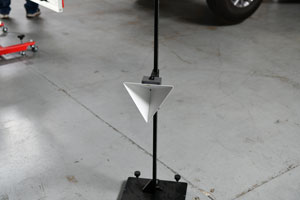 This triangular deflector is used to test and calibrate vehicle radar systems. Placed at the OEM-prescribed distance, it supplies immediate feedback to the ADAS calibration equipment. |
The lab’s equipment includes an Autel MaxiSys ADAS calibration unit complete with lasers, radar reflectors and targeting boards for all major manufacturers. The boards consist of differing black-and-white geometric patterns that help aim vehicle cameras. The lasers ensure precise distances, measurements and leveling when calibrating vehicles, and the deflectors act as calibration targets for radar beams.
“We bought the complete [Autel] package,” Yen said. “There are also a number of other manufacturers making ADAS calibration kits. It’s increasing every year.”
Korkis and Yen performed a live demonstration, recalibrating the lane-departure alert on a Toyota Tacoma truck raised to simulate the 6-in. lift of an aftermarket kit. On that particular model, they learned that changing the height measurement in the software and calibration were required for safety compliance.
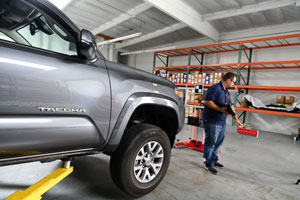 Ensuring that rearview cameras satisfy FMVSS111 requirements can take a lot of room—and a lot of different targets and patterns for differing vehicle models. Hansen VTF Labs has invested heavily in the proper equipment. |
“If we were keeping everything in the systems the same, it would fail the calibration,” Yen explained. “The vehicle doesn’t know the height has changed but if you tell the software that the height of the camera has moved up X amount of distance, it will successfully calibrate.”
Of course, it’s not always so easy. A Toyota Prius was also equipped with a front radar unit hidden behind its grille emblem. After a collision, a repairer shopped for new emblems online and chose a low-cost replacement. But after the repair, the car would suddenly brake for no apparent reason during test drives. The Hansen VTF Labs crew was able to isolate the problem: The replacement part was an incorrect emblem that interfered with the radar, triggering the vehicle’s automatic emergency braking system.
According to Yen, that is an increasingly common pitfall confronting repairers and vehicle modifiers.
“As soon as you remove that emblem and the radar is connected to it, Toyota will recommend that it be recalibrated,” he said. “But [the repair shop techs] are probably not going to know that because they aren’t up to date with OEM position statements. They’re just doing a simple swap of a part and think everything’s fine.”
In another case, a DIY repair to a Mazda 3 with radar sensors mounted behind the rear bumper resulted in failed blind-spot warnings. Although the owner had properly realigned everything during bumper replacement, he reused the original sensor mounts, which appeared undamaged. However, the lab eventually determined that the mounts were imperceptibly bent. Fresh hardware fixed the problem.
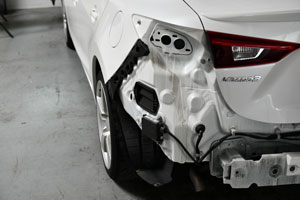 Fender replacement on this Mazda 3 disrupted its rear radar unit, even though everything seemed aligned. Testing ultimately determined that an imperceptible bend in the sensor’s mounting bracket was throwing off blind-spot detection. |
“A lot of these parts, especially radar units, are very prone to damage,” Yen said. “If you drop one, the OEMs will recommend just to replace it because something inside could have been messed up or damaged at that point and you won’t know until you try recalibrating the radar sensor.”
Those examples illustrate why OEMs are meticulous about their policies and procedures for repairing or replacing parts—and the potential liabilities of failing to follow them. A vehicle won’t necessarily throw a warning light or code to tell you when ADAS components are out of whack. Adding to the confusion, each OEM has different calibration procedures for each of its vehicle models. No wonder that numerous local bodyshops, including mom-and-pop operations, have turned to Hansen VTF Labs’ expertise in ADAS diagnostics.
“We’re definitely educating our local bodyshops,” Korkis said. “Not everyone knows about this yet—for example, windshield replacement businesses. Because there are so many features inside that glass, the cost has gone up just for the windshield glass itself. Now you have to add on [the costs of] additional calibration for that little lane camera that recognizes lane departure.”
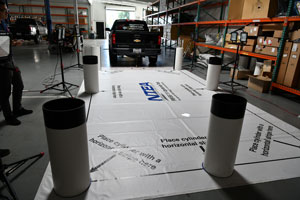 Korkis makes final adjustments to the Autel unit for calibration. He will read the scan data from the diagnostic tablet he holds in his right hand. After calibration of the ADAS systems, the truck will go on a test drive to verify the systems perform correctly and safely. |
Yen added that even used-car dealers who get their vehicles at auction are feeling the impact of ADAS.
“Not all cars are perfect at the auctions,” he explained. “Some have had some sort of hit in the corner or something. So they’ll buy it because it’s cheaper and fix it back up. We’ve visited many used-car lots to offer this service as well. Like anyone else, they’re not fully aware of these calibrations because there’s not necessarily a message on the dashboard that would tell you that your system is not working properly.”
Will the Hansen VTF Labs business model catch on? Chuck Hansen and his crew believe there’s a pressing need that will only grow with each advancing OE model year. They can envision many more calibration centers popping up soon to address that need for every type of aftermarket company that repairs, restores or modifies new and late-model vehicles. In the meantime, Hansen VTF Labs serves as another example of the specialty-equipment industry’s endless drive to innovate, try new things, and leverage emerging technologies.
| Hansen VTF Labs LLC 1555 W. Broadway, Anaheim CA 92802 657-230-8480 www.hansenvtflabs.com |



